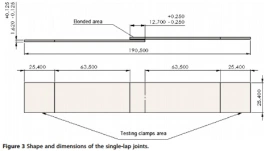 An article published on the JOURNAL OF THE EGYPTIAN SOCIETY OF TRIBOLOGY (VOLUME 14, No. 2, April 2017).
An article published on the JOURNAL OF THE EGYPTIAN SOCIETY OF TRIBOLOGY (VOLUME 14, No. 2, April 2017).
Archives du mot-clef Epoxy
Study on the creep behavior of bonded metallic joints
 Bonded joints have been used as the main alternative to join components made of different materials or not. Literature shows that although prior studies focused on the characterization of several mechanical properties related to joints, little is known about the creep behavior of bonded joints. This work studies the behavior of single-lap joints (SLJ) made of metallic substrate and bonded with epoxy and polyurethane adhesives. Results show that, for long term applications, the average tensile strength isn’t enough to guarantee project safety. An initial model for the creep behavior of bonded joints is proposed.
Bonded joints have been used as the main alternative to join components made of different materials or not. Literature shows that although prior studies focused on the characterization of several mechanical properties related to joints, little is known about the creep behavior of bonded joints. This work studies the behavior of single-lap joints (SLJ) made of metallic substrate and bonded with epoxy and polyurethane adhesives. Results show that, for long term applications, the average tensile strength isn’t enough to guarantee project safety. An initial model for the creep behavior of bonded joints is proposed.
Cliquez pour télécharger le texte complet de l’article paru via : http://www.appliedadhesionscience.com/content/pdf/2196-4351-2-8.pdf
